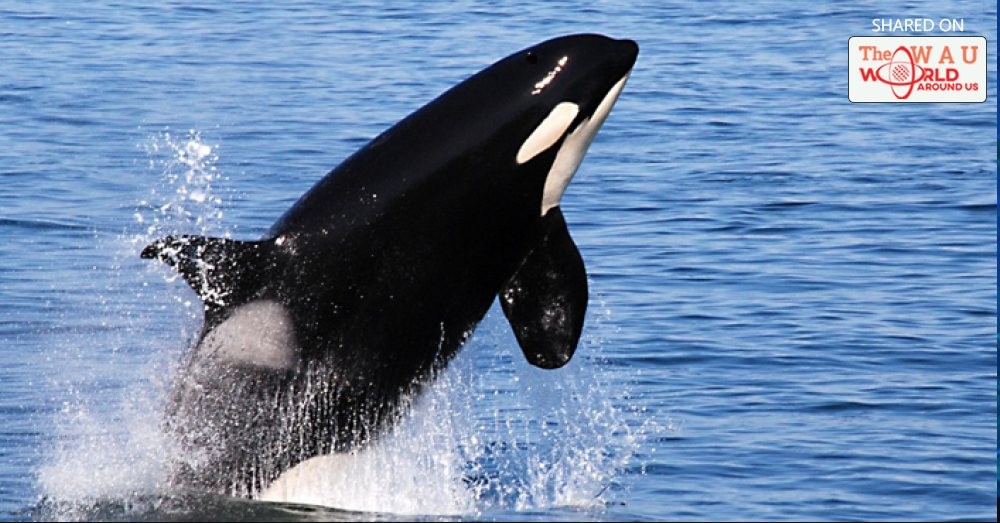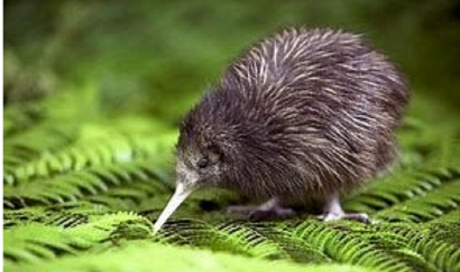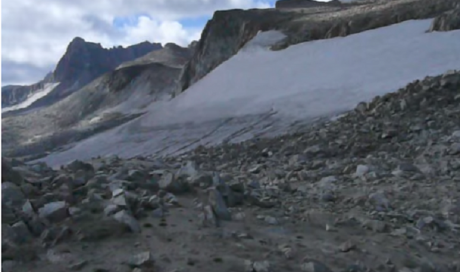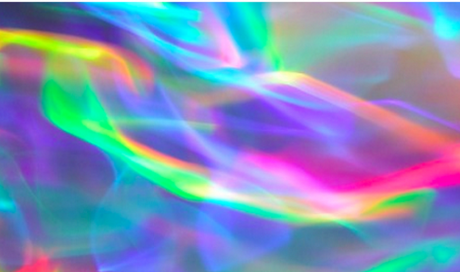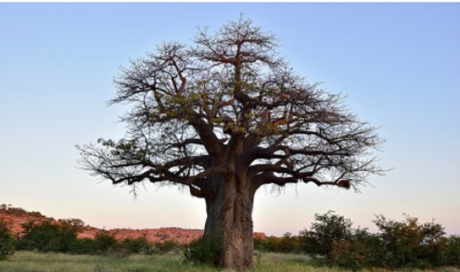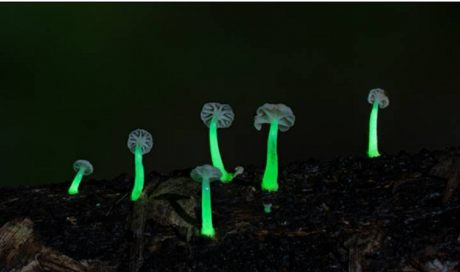The small killer whale being held aloft in the water off Saturna isn’t breathing, but the two larger whales holding it on the surface, waiting for a puff from their pod-mate’s blowhole, aren’t prepared to surrender. For killer whales, breathing is not an automatic act. If an orca is not conscious, it won’t inhale, and it needs to be on the surface to breathe. A killer can hold its breath underwater for about fifteen minutes—long enough to escape almost any attempt by a human to harass it—but an unconscious whale won’t live long. And if this whale regains its senses underwater and gasps for air, it may choke and drown before it can reach the surface. As shock sets in and consciousness fades, Burich’s victim is drowning. It is about five years old. That means one of the whales attempting to save it is probably its panicked mother or grandmother. The two larger whales consider their injured pod-mate. Is it already dead?
That doesn’t matter.
A mother orca in mourning may hold her dead calf above water for days and transport it for hundreds of miles.
The whales off Saturna know their companion isn’t dead. Killer whales can see about as well as humans. Anyone who has watched a killer and thought it was looking back at them from the water, or through the glass walls of an aquarium tank, was probably right. Killer whales see well enough to not just identify other creatures but to identify depictions of other creatures in paintings or photos. They can also recognize themselves in mirrors—a test used by scientists to determine self-awareness and intelligence.
But vision isn’t the most useful sense when you’re diving a hundred meters in murky water. Killer whales listen, using a sense called echolocation, which works like sonar technology. By emitting sound waves and tracking the echoes as they bounce off their targets, these whales can find and “see” anything in the water. As each of these two whales transmits a signal from the front of its head—the melon—they are able to sense the injured whale’s heart pounding, to listen to their baby choke as water seeps into its lungs.
Orcas can hear each other’s calls from more than ten miles away. Their senses are so acute that they can dive to the bottom of a pool to locate and retrieve an object half the size of a wedding ring. There’s a blind Marvel comics hero—Daredevil—whose hearing is enhanced like this, which makes him dangerous enough to defeat armies of ninjas. Orcas basically have the same superpower. They don’t just “see” objects; it’s possible they can echolocate what’s inside of them. There’s anecdotal evidence to suggest they can detect whether a female from our species is pregnant before the expectant mother can. So these whales know that their pod-mate’s organs are still functioning and that they won’t be for much longer. Orcas will work together to support and transport their injured mates for weeks at the risk of their own health.
People who have spent a lot of time around these whales suspect that they also have a sixth sense or, at the very least, an uncanny sense of timing. Ever since Burich and Bauer and the other men in their original hunting party arrived with their weapons, the whales have steered clear of their usual fishing grounds—a route they’ve probably been following for thousands of years. Maybe it’s a coincidence, maybe the salmon were somewhere else. And maybe it’s a coincidence that the killer whales only returned this morning, after the plan to harpoon them had been aborted, after the gun was supposed to be gone.
Veteran killer whale watchers and long time researchers all have stories about the ones that got away. They’ll tell you about the orcas that waited until the moment the cameras were no longer pointed at them—or the moment after the film ran out or the battery died—before doing something spectacular. Is it too much of a stretch to wonder if they can sense friend or foe? Some longtime whale watchers are convinced that orcas will perform when they have the chance to endear themselves to humans who are working to save them. Says Erich Hoyt, author of Orca: The Whale Called Killer: “Fanatic whale watchers—I’ve heard them talk—suggest that the friendlies, ‘the crowd pleasers,’ know their fate rests on humans and that they are on their best behavior with us, putting on one last show as it were before the big curtain, extinction, falls.”
Killer whales have also helped humans hunt. In North America and Australia, there are stories of orcas herding fish—and even other whales—to make it easier for fishermen to catch them. In the late nineteenth and early twentieth centuries, orcas near Eden, Australia, would drive humpback whales into an area known as Twofold Bay in exchange for their favorite pieces of meat—the tongue and the lips. This working relationship where the killer whales worked as whale killers for more than a hundred years was referred to by local fishermen as “the law of the tongue.”
According to the Eden Killer Whale Museum, “In the early years of Eden whaling in the 1840s there were reportedly around 50 killers spread through 3 main pods. All three pods cooperated together. One pod stationed far out to sea would drive whales in towards the coast, another pod would attack the whale and another pod would be stationed ahead of the whale in case it broke loose.” The whale believed to be the leader was a twenty-two-foot, thirteen-thousand-pound killer the whalers named Old Tom. After a humpback had been trapped, Tom would alert the whalers by slapping his tail and repeatedly breaching (jumping out of the water and landing with a splash) to summon the humans to finish off the kill. There were also stories of fishermen falling into the shark-infested waters when their boats were swamped by a humpback and Tom and other orcas warding the sharks off and saving their partners’ lives.
In 1923, when a local whaler refused to share his catch and injured Tom in a tug of war that damaged his teeth, most of the pod stopped herding the humpbacks, proving that this wasn’t a natural behavior. It was a job, and if the orcas weren’t being paid, they weren’t showing up for work. But Tom continued to herd larger whales for his taste of tongue. When Tom died in 1930—as a result of the teeth he lost—the people of Eden built their whale museum to honor their longtime partner and display his bones. The Australians of Eden had worked with the orcas for almost a hundred years. The indigenous people of the area, the Koori, are believed to have worked in harmony with the whales for ten thousand years. And anyone who has ever seen a killer whale in captivity knows they can be trained to do practically anything in the water. Killer whales know how to work with humans—and save them—but humans have rarely been inclined to help the killers.
The whales off Saturna knew what humans usually did when they came close in their boats. The humans shot them. But as Burich and Bauer approach, the orcas can’t move quickly or far—even if it means risking being harpooned like their pod-mate. They won’t let their baby drown.
In the early 1970s, Michael Bigg was working as a marine mammal research scientist for Canada’s Department of Fisheries, and part of his job was to assess the killer whale population now that orcas were being captured and displayed by marine parks. Fishermen and killer whale “collectors” believed there were thousands, perhaps tens of thousands, of wild whales roaming the Pacific coast.
The initial plan was to tag the orcas, but after talking with Vancouver Aquarium curator Murray Newman, Bigg settled on a more radical idea—simultaneous observations. Over the course of a weekend, volunteers located along the coast would spot and count the killer whales. Bigg sent a questionnaire to fifteen thousand people who lived and worked on the water and asked them to report all the whales they saw on July 26, 1971. Only 549 whales were spotted by volunteer scouts between California and Alaska.
That first census shocked everyone. It didn’t seem possible that there were only a few hundred orcas in the region. Then Bigg adopted an even more rigorous—and controversial—approach. In 1973, he and Ian MacAskie—his colleague from Canada’s Pacific Biological Station in Nanaimo—were studying whales in the Johnstone Strait when they realized they could tell the individuals apart by the nicks, scratches, and marks on their dorsal fins and the shape of each whale’s “saddle patch”—a unique pattern located behind the dorsal fin. Researchers in Africa were identifying individual mammals based on their features, so why not attempt the same approach with killer whales?
Bigg and his partners soon identified all the local pods, designating every group with a letter of the alphabet and numbering each individual whale. The first killer they saw was number one, the second was number two, and so on. The term “pod” is said to have originated from the fact that whales stay close together like the proverbial peas in a pod—and Bigg proved these pods really did stick together.
The idea that every killer whale could be identified on sight was initially dismissed and even ridiculed by other researchers. Not only did photo identification strike other scientists as impossible; no one believed that there were so few orcas off the coast of Washington and British Columbia. The American government was skeptical of Bigg’s methods—and his math—and hired its own expert—zoologist Kenneth Balcomb—to determine whether there were more orcas in the U.S. Balcomb, who fondly refers to Bigg as “the crazy Canadian,” conducted his own population survey in 1976. Not only did he confirm Bigg’s findings, but after launching a whale museum in Friday Harbor on San Juan Island, he began giving all the numbered whales catchy names to raise money for his research and conservation efforts. He wanted to convince people to adopt their own orcas, and it was much easier to convince kids to raid their piggy banks to support Ruffles, Granny, or Princess Angeline than J1, J2, or J17. After the museum had been launched, Balcomb became executive director of the Center for Whale Research in Washington, which doubles as his home. Balcomb has conducted an annual population survey ever since his first count and devoted his life to studying the whales found in the Juan de Fuca Strait, Strait of Georgia, and Puget Sound—an area that was renamed the Salish Sea in 2009 to honor the area’s origins and future.

The orca’s fierce reputation was well earned.
What Burich and Bauer didn’t know, what no one knew, was something else Bigg would discover—that there are multiple types of killer whales, which are so distinct that it is likely that, if they survive long enough, they will one day be considered different species. The different kinds of killer whales—known as ecotypes—don’t look exactly the same, and although they are capable of breeding with each other, and have mated when forced together in marine parks, there is no evidence that they have bred with each other in the wild in more than 700,000 years. The mammal-eating orcas that Bigg dubbed transients are as different from the fish-eating whales he called residents as lions are from house cats. Not only do residents and transients have different feeding and hunting habits, but they also have different languages, rules, and rituals. When the two types of whales meet in the wild, the transients tend to steer clear of the residents.
Thanks to aquariums where orcas serve time as star attractions, and movies like Free Willy, loveable, chatty resident whales with their close-knit families and seafood diet have captured the global imagination and become the default image not just for orcas but for every whale from belugas to blues. Resident killer whales travel and hunt in close-knit family groups, constantly communicate, and feed on specific types of fish, determined by the part of the world they live in. Studies of dead residents have revealed that their diets are so specialized that when they’re living in the wild, they will almost never deviate from it, even if the alternative is starvation. On the west coast of North America there are two groups of residents—the northerns, who roam between southeast Alaska and southern
Vancouver Island, and the southerns, who live along the rest of Vancouver Island, including the waters near Saturna. These whales travel all the way down to California.
The orcas who earned killer whales their reputations as monsters were the transients, which scientists now refer to as Bigg’s whales. Bigg’s whales are less social, less chatty, and less picky about their food. These whales are larger, with sharper dorsal fins. They hunt in packs like wolves—the mammal they have often been compared with by anyone who has seen them hunt.
Humans watching killer whales over the years were convinced that these whales enjoy hunting, since they’ll catch a favourite menu item, like a seal, and flip it into the air to kill it. They’ve also been known to allow their prey to escape before catching it again. These are probably older whales training their children, but regardless of their reasons, the methods earned killer whales a reputation for methodically tracking their prey and also for tormenting it—as if they’re playing with their food. After stalking seals and sea lions and punting them into the air until they’re dead, they peel the skin off their prey and discard it as if they’re snacking on bananas. And their prey includes much larger whales—like minkes, grays, and humpbacks. They are also known to eat other animals that have wandered into or near the water—including birds and moose.
Old Tom and his clan were Australian mammal eaters. When the orcas take down another whale, it’s a savage kill, the stuff of nightmares, even for seasoned whalers. This isn’t legend; it’s reality. Orcas are the ocean’s apex predator. There may be no reason for humans to be afraid of transient killer whales—since they rarely attack anything they’re not planning to eat—but to any creature that’s part of their diet, they are the ultimate black and white horror movie, the destroyer of worlds, death. And since they eat the largest animals on earth, why wouldn’t these unstoppable killing machines feast on human flesh?
There are a few theories about why orcas don’t attack humans in the wild, but they generally come down to the idea that orcas are fussy eaters and only tend to sample what their mothers teach them is safe. Since humans would never have qualified as a reliable food source, our species was never sampled.
So why wouldn’t they mistake us for food if we fell into the water?
Because they don’t rely on their sight.
A shark will take a bite of a surfer and then spit it out because, apparently, we’re not as tasty as fish and seals. But orcas use echolocation to lock in on their prey. If a human disguised himself as a sea lion, the whale would know that the idiot in the sea lion suit isn’t part of a balanced breakfast.
Another possible explanation is that, unlike our species, orcas would never harm another creature they consider intelligent. Even though Bigg’s whales eat other whales and don’t mix with residents, the mammal-eating orcas don’t harm their pescatarian, pacifist cousins.
Because of Bigg’s work, scientists and whale watchers now know almost every orca in the Salish Sea on sight. His research led to the southern residents being placed on the endangered species list in Canada in 2001 and in the U.S. in 2005. Today, the southern residents are considered one of the most endangered populations of any species on the planet.
In 2015, the U.S. National Marine Fisheries Service declared the southern resident killer whales one of the eight most endangered marine populations in America, and they are the only officially endangered orca population in the world. At the start of spring 2016, after a year that saw the biggest baby boom since the 1970s, there were only eighty-three southern residents in the Salish Sea. But in 1964, the belief was that there were too many killer whales, they were ferocious, and, at best, they were a pest that should be eradicated.
The young whale drowning off the coast of Saturna was a southern resident, which meant the only item on its menu was Chinook salmon.
In 1964, it was the salmon diet that had earned killer whales their designation as public enemy number one. A half dozen years earlier, there may have been enough salmon in British Columbia for whales, but there weren’t enough to satisfy humans. Fishermen blamed the killer whales, which were swimming beyond their usual hunting grounds in search of sustenance. Industry leaders demanded that the government step in to solve the whale problem.
Proposals from government officials included arming the coast guard with explosive bullets, bazookas, dynamite, depth charges, and mortars. One plan called for boats to herd the killers into shallow waters so that the air force could bomb the pods. One Canadian fisheries officer suggested using a baited line to entice whales to come close enough to harpoon. He was certain that if the harpoon failed to finish off the beast, the other members of the pod would do the job, saying, “There would seem little doubt that the cannibalistic traits of the rest of the shoal, if left alone, would soon put the finishing touches on him.” The fishermen believed that the whales were like sharks and that blood—even from their own kind—would ignite a feeding frenzy.
Finally, the Department of Fisheries settled on a more civilized solution than explosives. In June 1961, a fifty-caliber machine gun was mounted on the Vancouver Island side of Seymour Narrows to kill the whales. Seymour Narrows is roughly 140 miles away from Saturna.
The gun was never fired, but not because anyone protested. It was a dry, hot summer, and there were fears a stray bullet might spark a forest fire. Also, once the gun was mounted, the killers steered clear of Quadra, just as they stayed away from Saturna after the aquarium’s hunters arrived. In 1962, the salmon stocks returned and the fishermen assumed their competitors had already been culled.
The morning of July 16, 1964, the killer whales off the coast of Saturna were using their acute acoustic senses to track salmon. From April to October each year, the whales swim more than seventy-five miles a day and can travel at up to twenty miles per hour as they stalk Chinook, which regularly cozy up close to the shores of Saturna.
On a good day, an adult killer whale eats up to three hundred pounds of salmon.
On a bad day, there are no salmon and the whales don’t eat.
On a very bad day, a whale gets hit by a harpoon.
Share This Post

